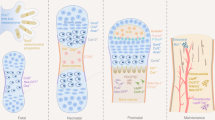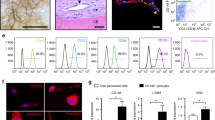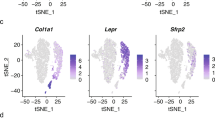Abstract
Human skeletal stem cells (hSSCs) hold tremendous therapeutic potential for developing new clinical strategies to effectively combat congenital and age-related musculoskeletal disorders. Unfortunately, refined methodologies for the proper isolation of bona fide hSSCs and the development of functional assays that accurately recapitulate their physiology within the skeleton have been lacking. Bone marrow-derived mesenchymal stromal cells (BMSCs), commonly used to describe the source of precursors for osteoblasts, chondrocytes, adipocytes and stroma, have held great promise as the basis of various approaches for cell therapy. However, the reproducibility and clinical efficacy of these attempts have been obscured by the heterogeneous nature of BMSCs due to their isolation by plastic adherence techniques. To address these limitations, our group has refined the purity of individual progenitor populations that are encompassed by BMSCs by identifying defined populations of bona fide hSSCs and their downstream progenitors that strictly give rise to skeletally restricted cell lineages. Here, we describe an advanced flow cytometric approach that utilizes an extensive panel of eight cell surface markers to define hSSCs; bone, cartilage and stromal progenitors; and more differentiated unipotent subtypes, including an osteogenic subset and three chondroprogenitors. We provide detailed instructions for the FACS-based isolation of hSSCs from various tissue sources, in vitro and in vivo skeletogenic functional assays, human xenograft mouse models and single-cell RNA sequencing analysis. This application of hSSC isolation can be performed by any researcher with basic skills in biology and flow cytometry within 1–2 days. The downstream functional assays can be performed within a range of 1–2 months.
This is a preview of subscription content, access via your institution
Access options
Access Nature and 54 other Nature Portfolio journals
Get Nature+, our best-value online-access subscription
$29.99 / 30 days
cancel any time
Subscribe to this journal
Receive 12 print issues and online access
$259.00 per year
only $21.58 per issue
Buy this article
- Purchase on Springer Link
- Instant access to full article PDF
Prices may be subject to local taxes which are calculated during checkout





Similar content being viewed by others
Data availability
All raw and processed scRNAseq data presented in this study have been submitted to the National Center for Biotechnology Information Gene Expression Omnibus online repository and are available under accession number GSE212609. We will share all other raw data upon request.
References
Ono, N., Balani, D. H. & Kronenberg, H. M. Stem and progenitor cells in skeletal development. Curr. Top. Dev. Biol. 133, 1–24 (2019).
Matsushita, Y., Ono, W. & Ono, N. Skeletal stem cells for bone development and repair: diversity matters. Curr. Osteoporos. Rep. 18, 189–198 (2020).
Ambrosi, T. H., Longaker, M. T. & Chan, C. K. F. A revised perspective of skeletal stem cell biology. Front. Cell. Dev. Biol. 13, 189 (2019).
Dzierzak, E. & Bigas, A. Blood development: hematopoietic stem cell dependence and independence. Cell Stem Cell 22, 639–651 (2018).
Haas, S., Trumpp, A. & Milsom, M. D. Causes and consequences of hematopoietic stem cell heterogeneity. Cell Stem Cell 22, 627–638 (2018).
Sakamaki, T. et al. Hoxb5 defines the heterogeneity of self-renewal capacity in the hematopoietic stem cell compartment. Biochem. Biophys. Res. Commun. 539, 34–41 (2021).
Pittenger, M. F. et al. Multilineage potential of adult human mesenchymal stem cells. Science 284, 143–147 (1999).
Jiang, Y. et al. Pluripotency of mesenchymal stem cells derived from adult marrow. Nature 418, 41–49 (2002).
Kagami, H., Agata, H. & Tojo, A. Bone marrow stromal cells (bone marrow-derived multipotent mesenchymal stromal cells) for bone tissue engineering: basic science to clinical translation. Int. J. Biochem. Cell Biol. 43, 286–289 (2011).
Friedenstein, A. J., Chailakhyan, R. K. & Gerasimov, U. V. Bone marrow osteogenic stem cells: in vitro cultivation and transplantation in diffusion chambers. Cell Tissue Kinet. 20, 263–272 (1987).
Friedenstein, A. J., Gorskaja, J. F. & Kulagina, N. N. Fibroblast precursors in normal and irradiated mouse hematopoietic organs. Exp. Hematol. 4, 267–274 (1976).
Zhou, B. O., Yue, R., Murphy, M. M., Peyer, J. G. & Morrison, S. J. Leptin-receptor-expressing mesenchymal stromal cells represent the main source of bone formed by adult bone marrow. Cell Stem Cell 15, 154–168 (2014).
Hall, S. R. et al. Identification and isolation of small CD44-negative mesenchymal stem/progenitor cells from human bone marrow using elutriation and polychromatic flow cytometry. Stem Cells Transl. Med. 2, 567–578 (2013).
Huang, Y. et al. Characterization and immunogenicity of bone marrow-derived mesenchymal stem cells under osteoporotic conditions. Sci. China Life Sci. 63, 429–442 (2020).
Chan, C. K. et al. Identification and specification of the mouse skeletal stem cell. Cell 160, 285–298 (2015).
Chan, C. K. F. et al. Identification of the human skeletal stem cell. Cell 175, 43–56.e21 (2018).
Dominici, M. et al. Minimal criteria for defining multipotent mesenchymal stromal cells. The international society for cellular therapy position statement. Cytotherapy 8, 315–317 (2006).
Chung, M. T. et al. CD90 (Thy-1)-positive selection enhances osteogenic capacity of human adipose-derived stromal cells. Tissue Eng. Part A 19, 989–997 (2013).
Lange, A., Dlubek, D., Drabczak-Skrzypek, D., Bogunia-Kubik, K. & Emilia Marrow cells cultured in MSC medium expand to CD73, CD90 and CD105 cells of fibroblast-like morphology. Blood 106, 4319–4319 (2005).
Quirici, N. et al. Isolation of bone marrow mesenchymal stem cells by anti-nerve growth factor receptor antibodies. Exp. Hematol. 30, 783–791 (2002).
Sorrentino, A. et al. Isolation and characterization of CD146+ multipotent mesenchymal stromal cells. Exp. Hematol. 36, 1035–1046 (2008).
Sacchetti, B. et al. No identical “mesenchymal stem cells” at different times and sites: human committed progenitors of distinct origin and differentiation potential are incorporated as adventitial cells in microvessels. Stem Cell Rep. 6, 897–913 (2016).
Arthur, A. & Gronthos, S. Clinical application of bone marrow mesenchymal stem/stromal cells to repair skeletal tissue. Int. J. Mol. Sci. 21, 9759 (2020).
Mohamed-Ahmed, S. et al. Comparison of bone regenerative capacity of donor-matched human adipose-derived and bone marrow mesenchymal stem cells. Cell Tissue Res. 383, 1061–1075 (2021).
Elefteriou, F. Impact of the autonomic nervous system on the skeleton. Physiol. Rev. 98, 1083–1112 (2018).
Raaijmakers, M. H. et al. Bone progenitor dysfunction induces myelodysplasia and secondary leukaemia. Nature 464, 852–7 (2010).
Fornetti, J., Welm, A. L. & Stewart, S. A. Understanding the bone in cancer metastasis. J. Bone Miner. Res. 33, 2099–2113 (2018).
Murphy, M. P. et al. Articular cartilage regeneration by activated skeletal stem cells. Nat. Med. 26, 1583–1592 (2020).
Esposito, M., Guise, T. & Kang, Y. The biology of bone metastasis. Cold Spring Harb. Perspect. Med. 8, a031252 (2018).
Marecic, O. et al. Identification and characterization of an injury-induced skeletal progenitor. Proc. Natl Acad. Sci. USA 112, 9920–9925 (2015).
Ambrosi, T. H. et al. Aged skeletal stem cells generate an inflammatory degenerative niche. Nature 597, 256–262 (2021).
Ambrosi, T. H. et al. Geriatric fragility fractures are associated with a human skeletal stem cell defect. Aging Cell 19, e13164 (2020).
Gulati, G. S. et al. Isolation and functional assessment of mouse skeletal stem cell lineage. Nat. Protoc. 13, 1294–1309 (2018).
Goodnough, L. H. Cross-species comparisons reveal resistance of human skeletal stem cells to inhibition by non-steroidal anti-inflammatory drugs. Front. Endocrinol. 13, 924927 (2022).
Ambrosi, T. H. et al. Distinct skeletal stem cell types orchestrate long bone skeletogenesis. eLife 10, e66063 (2021).
Morton, J. J. et al. Dual use of hematopoietic and mesenchymal stem cells enhances engraftment and immune cell trafficking in an allogeneic humanized mouse model of head and neck cancer. Mol. Carcinog. 57, 1651–1663 (2018).
Mian, S. A., Anjos-Afonso, F. & Bonnet, D. Advances in human immune system mouse models for studying human hematopoiesis and cancer immunotherapy. Front. Immunol. 2, 619236 (2021).
Jain, R. & Jain, P. C. Production and partial characterization of collagenase of Streptomyces exfoliatus CFS 1068 using poultry feather. Indian J. Exp. Biol. 48, 174–178 (2010).
Steinhardt, R. Rips repaired. Nature 436, 925 (2005).
Picelli, S. et al. Full-length RNA-seq from single cells using Smart-seq2. Nat. Protoc. 9, 171–181 (2014).
Wang, X., He, Y., Zhang, Q., Ren, X. & Zhang, Z. Direct comparative analyses of 10X Genomics chromium and Smart-seq2. Genomics Proteom. Bioinforma. 19, 253–266 (2021).
Ziegenhain, C. et al. Comparative analysis of single-cell RNA sequencing methods. Mol. Cell 65, 631–643.e4 (2017).
Acknowledgements
We thank B. Barres, J. Janas and R. Mann for their support and mentorship; A. McCarty and C. Wang for mouse colony management; H. Gentner, P. Pereira, T. Storm, T. Naik, L. Quinn, L. Jerabek, S. Kantoff and C. McQuarrie for lab management; P. Lovelace, J. Ho and S. Weber for FACS support; and J.C. Wu for the kind gift of iPSC line. This study was supported by NIH (R01DE027323, R56 DE025597, R01 DE026730, R01 DE021683, R21 DE024230, U01HL099776, U24DE026914 and R21DE019274), CIRMTR1-01249, Oak Foundation, Stanford Wu Tsai Human Performance Alliance Funds, Hagey Laboratory, Pitch Johnson Fund and Gunn/Olivier Research Fund to M.T.L., NIH (U01 HL099999, R01 CA86065, and R01 HL058770), Siebel Fellowship, the Heritage Medical Foundation, Prostate Cancer Foundation, the American Federation for Aging Research (AFAR)–Arthritis National Research Foundation (ANRF), a seed grant from the WHSDM Stanford Women’s Health and Ses Differences in Medicine Center, an endowment from the DiGenova Family to C.K.F.C., PCF YI Award, Stinehart/Reed and NIH NIAK99AG049958-01A1 to C.K.F.C., NIH (I01)VA I01BX003754 and NIH K08GM069677 to G.Y., HHMI Fellowship to G.S.G., PSRF to M.P.M., the German Research Foundation (DFG-Fellowship) 399915929 and NIH/NIA 1K99AG066963 to T.H.A., NIH P50-HG007735 to H.Y.C., NIH (R01 AR055650 and R01 AR063717) and the Ellenburg Chair to S.B.G., NIH S10 RR02933801 to Stanford Stem Cell FACS core, European Union’s Horizon 2020 research innovation program (grant agreement no. 733006 to DS and no. 731377 to KS) and Land Salzburg WISS 2025 F 2000237-FIP “STEBS” to DS. Additional support came from NIH S10 1S10OD028493-01A1 for acquisition of a microfluidic chip-based system for cluster sorting and dispensing (Principal Investigator: Charles. K.F. Chan) and NIH S10 1S10OD02349701.
Author information
Authors and Affiliations
Contributions
C.K.F.C., T.H.A., M.T.L. and R.S. conceived the isolation strategy and functional assays. C.K.F.C. and M.T.L. supervised the project. T.H.A., M.Y.H, H.M.S., L.S.K., M.P.M. and Y.W. developed the protocol, performed the experiments and analyzed the data. M.Y.H. wrote the manuscript. A.A.A., E.J.A., L.Z., M.G.K.B., E.T. and S.P.S. assisted with flow cytometry, in vitro assays and manuscript preparation. J.B., M.G., S.H. and S.G. provided clinical skeletal specimens and edited the manuscript. D.S., R.S., M.M. and N.N. assisted in the bioinformatics and single-cell sequencing platforms.
Corresponding author
Ethics declarations
Competing interests
The authors declare no competing interests.
Peer review
Peer review information
Nature Protocols thanks Matthew Greenblatt, Noriaki Ono, and the other, anonymous, reviewer(s) for their contribution to the peer review of this work.
Additional information
Publisher’s note Springer Nature remains neutral with regard to jurisdictional claims in published maps and institutional affiliations.
Related links
Key references using this protocol
Chan, C. K. F. et al. Cell 175, 43–56.e21 (2018): https://doi.org/10.1016/j.cell.2018.07.029
Murphy, M. P. et al. Nat. Med. 26, 1583–1592 (2020): https://doi.org/10.1038/s41591-020-1013-2
Ambrosi, T. H. et al. Aging Cell 19, e13164 (2020): https://doi.org/10.1111/acel.13164
Extended data
Extended Data Fig. 1 FACS gating strategy for other hSSC sources.
FACS gating plots for other three hSSC sources, including: fracture callus (28-year-old clavicle), femoral head (87-year-old) and iPSCs (human-monocyte-derived line, SCVI 113).
Extended Data Fig. 2 FACS gating strategy for SSCs of bone marrow reamings.
FACS gating plots for SSCs collected from human bone marrow reamings of 22-year-old femur (top) and 87-year-old hip (bottom).
Extended Data Fig. 3 Fluorescence Minus One (FMO) gating strategy.
FMO controls help to define the negative signal for the given antibody and allow for a more informed gating strategy. Cells were isolated from a 76-year-old male femoral head. Representative plots were generated on a FACS Aria II for each FMO (eg. anti-Tie2/CD31 in APC-Cy7, anti-CD235/CD45/DAPI in Pacific Blue, anti-PDPN in APC, anti-CD146 in PE-Cy7, anti-CD73 in FitC, and anti-CD164 in PE).
Rights and permissions
Springer Nature or its licensor (e.g. a society or other partner) holds exclusive rights to this article under a publishing agreement with the author(s) or other rightsholder(s); author self-archiving of the accepted manuscript version of this article is solely governed by the terms of such publishing agreement and applicable law.
About this article
Cite this article
Hoover, M.Y., Ambrosi, T.H., Steininger, H.M. et al. Purification and functional characterization of novel human skeletal stem cell lineages. Nat Protoc 18, 2256–2282 (2023). https://doi.org/10.1038/s41596-023-00836-5
Received:
Accepted:
Published:
Issue Date:
DOI: https://doi.org/10.1038/s41596-023-00836-5
Comments
By submitting a comment you agree to abide by our Terms and Community Guidelines. If you find something abusive or that does not comply with our terms or guidelines please flag it as inappropriate.



